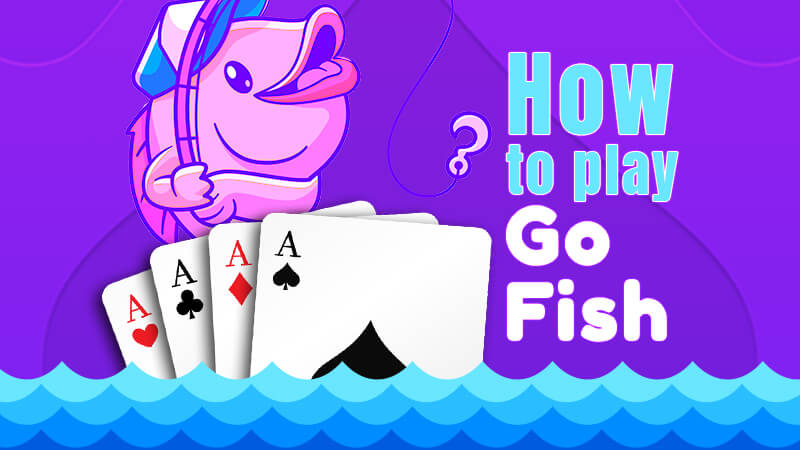We’ll cover everything you need to know about how to play Go Fish, including the rules and some tips on how to win.
Let’s dive in and start having some Go Fish fun!
1. Setting Up the Game
The goal of the game is to collect as many complete sets of four numerically matching cards (one from each suit) as you can. It’s usually played by two to five players, although it can be played with up to 10 players.
To start the game, you need at least one opponent and a standard 52-card deck. Remove the jokers, they are not needed in a game of Go Fish.
The dealer gives every player 7 cards (if you’re a group of up to 3 players), or 5 cards (if it’s a group of 4 and more platers). All players can look at their cards. The rest of the cards are the so-called “fishing pond.” Spread all the remaining cards face-down in the middle of the table.
2. How to play Go Fish
Now you have all the players and equipment, and the game is set, it’s time to play Go Fish!
Ask for a card
The first player looks at their hand and opt to inquire about cards need from other players. It’s advisable to complete sets as fast as possible. For example, if you have two or three of a kind, it makes sense to ask for the card that would complete the set. You can ask only one person at a time and one card rank per turn. Also, you only ask for a rank, not a suit.
Take, or “go fish”
If your designated player has the card asked for, they have to give it to you. If they do not possess the card, they would tell you to “go fish” and you would have to pick a card from the fishing pond in the middle of the table. This way, you would either complete a set, or gain a different rank card and would have to start another set.
Next player does the same
After your turn, the next player asks for a card and the game continues until everyone has had their turn. If you’re asked for a card, you must give it if it’s in your hand. If you don’t have this card, you tell the player to “go fish”. Of course, for maximum enjoyment, it’s imperative that you don’t cheat and keep the cards for yourself. Eventually, you will be revealed, as players pay good attention.
Complete sets
If luck is on your side and you consistently find the cards you need for matches, you might enjoy multiple consecutive turns before needing to “go fish” and pass the turn. During your turns, feel free to ask the same person for a different card or approach a new player. Each complete set is taken from your hand and put aside.
Win the game by finishing all your cards
The winner is the first player to empty their hand, while additional rounds can determine second, third, and subsequent placings. For an alternative approach, continue playing until all fishing pond and player’s hand cards are revealed. Count the matches each player has, and the one with the most matches is the winner.
3. Go Fish rules to win the game
Lay down 4-of-a-kind matches
According to the rules of Go Fish, keeping matches in your hand isn’t allowed. Once acquired, they must be placed in front of you for all to see. Quick match-making is vital, especially in versions where the first to empty their hand wins. Some variations permit 2-card matches instead of 4-of-a-kind. Collections of 4 cards are often referred to as “books.”
Take another turn after laying down a match
Successfully laying down a match allows your turn to persist, granting you the opportunity to initiate your next match before others have the chance to claim your cards.
Play until the fishing pond is empty
This flexible conclusion is ideal for fast-paced games. You might opt to declare the player with the most matches as the winner, or simply call it a draw. Extending play beyond the empty fishing pond is another option, where turns involve obtaining cards from opponents without needing to “go fish” at the turn’s end.
4. Different variations
Like many other card games that gained popularity globally, Go Fish has different variations in different parts of the world. Some of the most notable ones are:
- Australian Fish. In the variant known as “Australian Fish,” players actively request cards that match ones they hold, leading to the formation of pairs. Once a pair is formed, it’s placed face up. The strategy here lies in identifying the pairs among your cards and collaborating to complete them efficiently.
- Omben / Minuman. The Indonesian version, “Omben” or “Minuman,” adds an intriguing twist. Players request ranks from opponents, and if they hold the requested card, they must hand it over. However, if a player doesn’t possess the requested card, they’re required to “drink” by drawing cards from the pile until they find the right one.
- Authors. “Authors” introduces a unique approach by focusing on acquiring specific cards to create complete sets. Players engage in requesting individual cards that contribute to forming a complete set.
- Quartett (Happy Families). In the German “Quartett” or “Happy Families,” the primary goal is to complete quartets. Players actively request specific cards that belong to quartets, aiming to gather the most quartets and secure victory.


